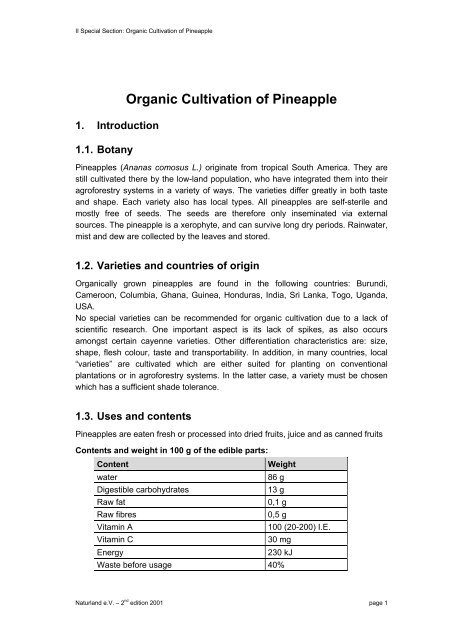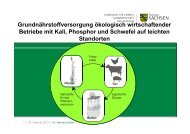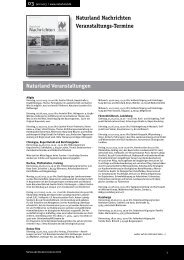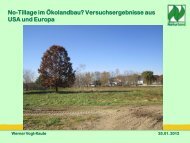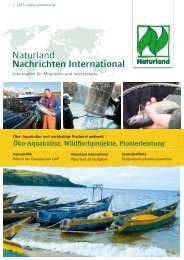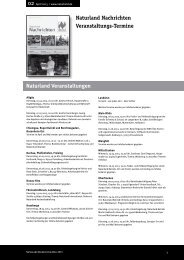Organic Farming in the Tropics and Subtropics: Pineapple - Naturland
Organic Farming in the Tropics and Subtropics: Pineapple - Naturland
Organic Farming in the Tropics and Subtropics: Pineapple - Naturland
You also want an ePaper? Increase the reach of your titles
YUMPU automatically turns print PDFs into web optimized ePapers that Google loves.
II Special Section: <strong>Organic</strong> Cultivation of P<strong>in</strong>eapple<br />
1. Introduction<br />
1.1. Botany<br />
<strong>Organic</strong> Cultivation of P<strong>in</strong>eapple<br />
P<strong>in</strong>eapples (Ananas comosus L.) orig<strong>in</strong>ate from tropical South America. They are<br />
still cultivated <strong>the</strong>re by <strong>the</strong> low-l<strong>and</strong> population, who have <strong>in</strong>tegrated <strong>the</strong>m <strong>in</strong>to <strong>the</strong>ir<br />
agroforestry systems <strong>in</strong> a variety of ways. The varieties differ greatly <strong>in</strong> both taste<br />
<strong>and</strong> shape. Each variety also has local types. All p<strong>in</strong>eapples are self-sterile <strong>and</strong><br />
mostly free of seeds. The seeds are <strong>the</strong>refore only <strong>in</strong>sem<strong>in</strong>ated via external<br />
sources. The p<strong>in</strong>eapple is a xerophyte, <strong>and</strong> can survive long dry periods. Ra<strong>in</strong>water,<br />
mist <strong>and</strong> dew are collected by <strong>the</strong> leaves <strong>and</strong> stored.<br />
1.2. Varieties <strong>and</strong> countries of orig<strong>in</strong><br />
<strong>Organic</strong>ally grown p<strong>in</strong>eapples are found <strong>in</strong> <strong>the</strong> follow<strong>in</strong>g countries: Burundi,<br />
Cameroon, Columbia, Ghana, Gu<strong>in</strong>ea, Honduras, India, Sri Lanka, Togo, Ug<strong>and</strong>a,<br />
USA.<br />
No special varieties can be recommended for organic cultivation due to a lack of<br />
scientific research. One important aspect is its lack of spikes, as also occurs<br />
amongst certa<strong>in</strong> cayenne varieties. O<strong>the</strong>r differentiation characteristics are: size,<br />
shape, flesh colour, taste <strong>and</strong> transportability. In addition, <strong>in</strong> many countries, local<br />
“varieties” are cultivated which are ei<strong>the</strong>r suited for plant<strong>in</strong>g on conventional<br />
plantations or <strong>in</strong> agroforestry systems. In <strong>the</strong> latter case, a variety must be chosen<br />
which has a sufficient shade tolerance.<br />
1.3. Uses <strong>and</strong> contents<br />
P<strong>in</strong>eapples are eaten fresh or processed <strong>in</strong>to dried fruits, juice <strong>and</strong> as canned fruits<br />
Contents <strong>and</strong> weight <strong>in</strong> 100 g of <strong>the</strong> edible parts:<br />
Content Weight<br />
water 86 g<br />
Digestible carbohydrates 13 g<br />
Raw fat 0,1 g<br />
Raw fibres 0,5 g<br />
Vitam<strong>in</strong> A 100 (20-200) I.E.<br />
Vitam<strong>in</strong> C 30 mg<br />
Energy 230 kJ<br />
Waste before usage 40%<br />
Naturl<strong>and</strong> e.V. – 2 nd edition 2001 page 1


